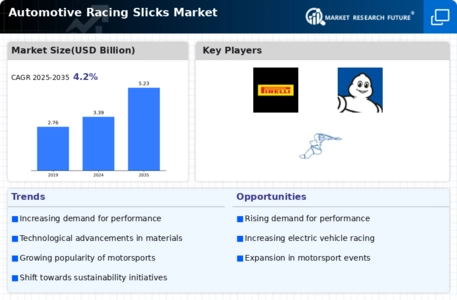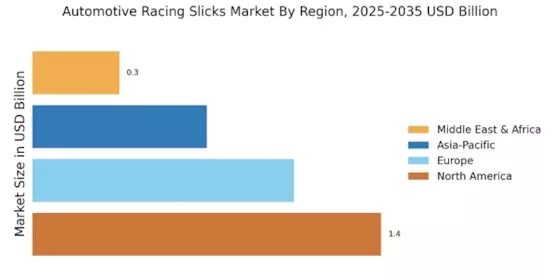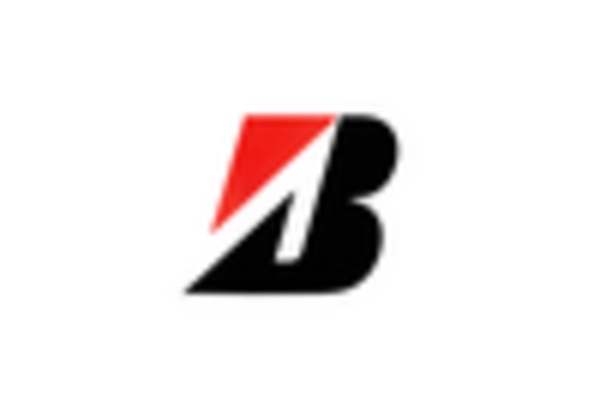Sustainability Initiatives
Sustainability initiatives are becoming increasingly relevant within the Automotive Racing Slicks Market. Manufacturers are now focusing on producing eco-friendly tires that minimize environmental impact while maintaining high performance. The shift towards sustainable materials, such as bio-based rubbers and recycled components, is gaining traction. This trend is not only appealing to environmentally conscious consumers but also aligns with regulatory pressures for reduced carbon footprints in manufacturing processes. Recent statistics indicate that the market for sustainable racing tires is expected to expand significantly, with a projected increase of 4.5% annually. As the automotive industry moves towards greener practices, the Automotive Racing Slicks Market is likely to adapt, leading to innovations that balance performance with environmental responsibility.
Data-Driven Performance Optimization
The integration of data-driven performance optimization is reshaping the Automotive Racing Slicks Market. Teams are increasingly utilizing telemetry and analytics to monitor tire performance in real-time, allowing for precise adjustments during races. This data-centric approach enables teams to optimize tire pressure, temperature, and wear patterns, ultimately enhancing overall vehicle performance. The use of advanced simulation tools and predictive analytics is also on the rise, providing insights that help in tire selection and strategy formulation. Market analysis suggests that the adoption of data analytics in racing is expected to grow by 6% over the next few years, reflecting a broader trend towards technology-driven decision-making in motorsports. Consequently, the Automotive Racing Slicks Market is likely to benefit from these advancements, as teams seek to gain a competitive edge through informed tire management.
Increased Participation in Motorsports
The Automotive Racing Slicks Market is witnessing a notable increase in participation across various motorsport events. This trend is fueled by the growing popularity of racing as a spectator sport and the rise of amateur racing leagues. As more individuals engage in motorsports, the demand for high-quality racing slicks is expected to rise correspondingly. Recent data indicates that the number of amateur racing events has increased by approximately 15% in the last two years, leading to a surge in tire sales. This influx of new racers is not only expanding the customer base for manufacturers but also driving innovation as companies strive to meet diverse performance needs. As the motorsports community continues to grow, the Automotive Racing Slicks Market is poised for sustained expansion, with manufacturers adapting their offerings to cater to this burgeoning audience.
Regulatory Changes and Safety Standards
Regulatory changes and evolving safety standards are playing a crucial role in shaping the Automotive Racing Slicks Market. As safety becomes a paramount concern in motorsports, governing bodies are implementing stricter regulations regarding tire specifications and performance criteria. These changes compel manufacturers to innovate and enhance their products to comply with new standards. For instance, recent regulations have mandated improved wet-weather performance and durability, prompting advancements in tire technology. Market forecasts suggest that compliance with these regulations could drive a 3% increase in the demand for specialized racing tires over the next few years. Consequently, the Automotive Racing Slicks Market must remain agile, adapting to regulatory shifts while ensuring that performance and safety are not compromised.
Technological Advancements in Tire Design
The Automotive Racing Slicks Market is experiencing a surge in technological advancements that enhance tire performance. Innovations in materials, such as the use of advanced polymers and composite materials, are leading to tires that offer improved grip and durability. For instance, the introduction of variable tread patterns allows for better heat dissipation and traction under various racing conditions. According to recent data, the market for high-performance racing tires is projected to grow at a compound annual growth rate of 5.2% over the next five years. This growth is driven by the increasing demand for competitive racing and the need for tires that can withstand extreme conditions. As manufacturers continue to invest in research and development, the Automotive Racing Slicks Market is likely to see even more sophisticated tire designs that cater to the evolving needs of racers.


















Leave a Comment